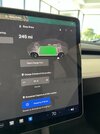Should I get a Model 3 Performance? Thanks in advance to anyone who reads and responds to my long post.
If anyone sees something I have left out in my research, please help to point it out to me! I'd really like to make this work.
Background:
So I rented a Model 3 Performance back in 2019. I have always been a fan. I want a model 3.
My issues are:
My garage is currently wired with one 120V/15A line from the breaker. I measured the plug in the garage to measure the wire size, it is 14 AWG. (Measured the wire at ~1.62mm). This means I cannot upgrade the breaker beyond 15A, safely. Taking into account the little chest fridge I have in there, my calculations show that: 1800W minus an assumed 200W for the fridge, and not taking into account the garage door since it doesn't open often, I have 1600 W left over.
This means I can only charge at 120V/13A IF the breaker does not trip from the garage door opening. If it does, I will have to decrease the charging amperage.
I have received quotes to install 240V from one Tesla recommended vendor in the area, of $4-$7K. The garage is not connected to my condo physically but the power in there ultimately comes from the breaker in my condo.
Assuming 75% efficiency, I get 1170W charging going to the car.
If I charge off peak on the EV2A PG&E scheme (still charging at partial peak) I can charge from 9 PM to 8AM when I leave for work. That gets 11 hours of charging a night.
This nets me around 15-16% charge to the battery.
My commute is 84 miles round trip, which comes out to 33% charge. (Calculated by ABRP).
I do have 6.6 kW (20 mi/hr) charging at work, however it is often taken by other tesla owners, so getting that is hit or miss.
If I want to keep charge between 75% and 30%, then I have to charge once every 2 days at work in order to stay above 30%.
I would like to avoid super charging if possible to prolong battery life.
The only alternative options I have thought of, is to charge during peak hours, or supercharge whenever I cannot get charging at work.
Does anyone think this is just too much of a hectic corner situation to own a Tesla? Have I missed anything that would make this easier?
If anyone sees something I have left out in my research, please help to point it out to me! I'd really like to make this work.
Background:
So I rented a Model 3 Performance back in 2019. I have always been a fan. I want a model 3.
My issues are:
My garage is currently wired with one 120V/15A line from the breaker. I measured the plug in the garage to measure the wire size, it is 14 AWG. (Measured the wire at ~1.62mm). This means I cannot upgrade the breaker beyond 15A, safely. Taking into account the little chest fridge I have in there, my calculations show that: 1800W minus an assumed 200W for the fridge, and not taking into account the garage door since it doesn't open often, I have 1600 W left over.
This means I can only charge at 120V/13A IF the breaker does not trip from the garage door opening. If it does, I will have to decrease the charging amperage.
I have received quotes to install 240V from one Tesla recommended vendor in the area, of $4-$7K. The garage is not connected to my condo physically but the power in there ultimately comes from the breaker in my condo.
Assuming 75% efficiency, I get 1170W charging going to the car.
If I charge off peak on the EV2A PG&E scheme (still charging at partial peak) I can charge from 9 PM to 8AM when I leave for work. That gets 11 hours of charging a night.
This nets me around 15-16% charge to the battery.
My commute is 84 miles round trip, which comes out to 33% charge. (Calculated by ABRP).
I do have 6.6 kW (20 mi/hr) charging at work, however it is often taken by other tesla owners, so getting that is hit or miss.
If I want to keep charge between 75% and 30%, then I have to charge once every 2 days at work in order to stay above 30%.
I would like to avoid super charging if possible to prolong battery life.
The only alternative options I have thought of, is to charge during peak hours, or supercharge whenever I cannot get charging at work.
Does anyone think this is just too much of a hectic corner situation to own a Tesla? Have I missed anything that would make this easier?




